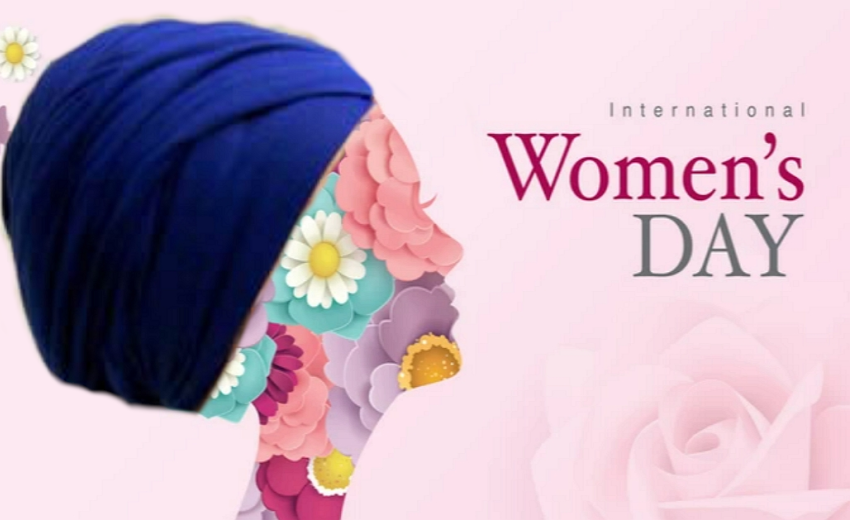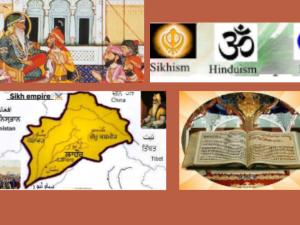Women represent half of all humanity, yet they continue to face discrimination in various parts of the world. The feminist movement has done much to lessen gender discrimination in western societies. However, women in much of the world still face severe difficulties, such as violence, illiteracy, economic and social deprivation [1]. It is increasingly recognized that better education and economic empowerment of women can play a significant role in uplifting the economic level of impoverished areas of the world and lowering birth rates, which is crucial for addressing climate change.
Having noted several general rituals and traditions of his time, Guru Nanak recognized that men often degraded women. They were thought of as property and treated as lowly and unworthy. He condemned these practices. Thus, several centuries ahead of the feminist movement, Guru Nanak spoke out against gender discrimination in India's highly male-dominated environment. He opposed established orthodoxy with the radical assertion that women were worthy of praise and equal to men. Besides, God is gender neutral. It is both man and woman, and its creative aspect is portrayed as that of a mother [2]:
ਆਪੇ ਪੁਰਖੁ ਆਪੇ ਹੀ ਨਾਰੀ ॥
Āpe purakẖ āpe hī nārī.
God (Creator) is both man and woman. (M. 1, SGGS, p 1020)
Guru Nanak proclaimed that the same divine essence pervades through both men and women.
ਨਾਰੀ ਪੁਰਖ ਸਬਾਈ ਲੋਇ ॥
Nārī purakẖ sabā▫ī lo▫e.
Among all the women and the men, God’s essence is pervading. (M. 1, SGGS, p. 223)
Bhagat Kabir, another author of Sri Guru Granth Sahib, articulates that man and women are all forms of the Creator (God).
ਏਤੇ ਅਉਰਤ ਮਰਦਾ ਸਾਜੇ ਏ ਸਭ ਰੂਪ ਤੁਮ੍ਹ੍ਹਾਰੇ ॥
Ėṯe a▫uraṯ marḏā sāje e sabẖ rūp ṯumĥāre.
(O Lord!) You have fashioned all these men and women. All these are Your forms. (Bhagat Kabir, SGGS, p. 1349)
Gur Nanak asserted that rather than being denigrated and mistreated, women should be cherished and respected. He proclaimed:
ਭੰਡਿ ਜੰਮੀਐ ਭੰਡਿ ਨਿੰਮੀਐ ਭੰਡਿ ਮੰਗਣੁ ਵੀਆਹੁ ॥ ਭੰਡਹੁ ਹੋਵੈ ਦੋਸਤੀ ਭੰਡਹੁ ਚਲੈ ਰਾਹੁ ॥ ਭੰਡੁ ਮੁਆ ਭੰਡੁ ਭਾਲੀਐ ਭੰਡਿ ਹੋਵੈ ਬੰਧਾਨੁ ॥ ਸੋ ਕਿਉ ਮੰਦਾ ਆਖੀਐ ਜਿਤੁ ਜੰਮਹਿ ਰਾਜਾਨ ॥ ਭੰਡਹੁ ਹੀ ਭੰਡੁ ਊਪਜੈ ਭੰਡੈ ਬਾਝੁ ਨ ਕੋਇ ॥ ਨਾਨਕ ਭੰਡੈ ਬਾਹਰਾ ਏਕੋ ਸਚਾ ਸੋਇ ॥
Bẖand jammī▫ai bẖand nimmī▫ai bẖand mangaṇ vī▫āhu. Bẖandahu hovai ḏosṯī bẖandahu cẖalai rāhu. Bẖand mu▫ā bẖand bẖālī▫ai bẖand hovai banḏẖān. So ki▫o manḏā ākẖī▫ai jiṯ jamėh rājān. Bẖandahu hī bẖand ūpjai bẖandai bājẖ na ko▫e. Nānak bẖandai bāhrā eko sacẖā so▫e.
We all are born of women; we are conceived in a woman's womb. To a woman, one is engaged and married. One makes friendship with a woman; through woman, future generations are born. When a woman (wife) dies, a person marries another one; we are bound with the world through woman. So why should we talk ill of her? From her, kings are born. From a woman, a woman is born; without women, there would be no one at all. O Nanak, God alone is without a woman. (M. 1, SGGS, p 473)
Guru Nanak and his successor Sikh Gurus actively encouraged women's participation as equals in worship, society, and the battleground. They supported freedom of speech, and women were encouraged to participate in all religious activities, including the Sri Guru Granth Sahib's reading. Guru Nanak granted equality to women by admitting them into the Sangat (congregation) without any restrictions or reservations. He asserted that his message was meant as much for women as for men. Guru Angad, the second Sikh Guru, encouraged the education of all Sikhs, both men and women [3]. Guru Amar Das, the third Sikh Guru, disfavored the use of the veil by women. He encouraged women to take up a leadership role in society and assigned women to supervise some communities of disciples. In addition, he forbade the practice of Sati (widow burning) and female infanticide and encouraged remarriage of widows [4-5]. Guru Amar Das proclaimed:
ਸਤੀਆ ਏਹਿ ਨ ਆਖੀਅਨਿ ਜੋ ਮੜਿਆ ਲਗਿ ਜਲੰਨ੍ਹ੍ਹਿ॥ਨਾਨਕ ਸਤੀਆ ਜਾਣੀਅਨ੍ਹ੍ਹਿ ਜਿ ਬਿਰਹੇ ਚੋਟ ਮਰੰਨ੍ਹ੍ਹਿ॥
Saṯī▫ā ehi na ākẖī▫an jo maṛi▫ā lag jalaʼnniĥ. Nānak saṯī▫ā jāṇī▫aniĥ jė birhe cẖot maraʼnniĥ.
Do not call them 'satee', who burn alive on their husband's funeral pyre. Nanak says: They alone be called 'satee', who die from the shock of separation. (M. 3, SGGS, p. 787)
Guru Ram Das, the fourth Sikh Guru, condemned the dowry ritual. He articulated:
ਹੋਰਿ ਮਨਮੁਖ ਦਾਜੁ ਜਿ ਰਖਿ ਦਿਖਾਲਹਿ ਸੁ ਕੂੜੁ ਅਹੰਕਾਰੁ ਕਚੁ ਪਾਜੋ ॥
Hor manmukẖ ḏāj jė rakẖ ḏikẖālėh so kūṛ ahaʼnkār kacẖ pājo.
A self-oriented person, who offers dowry and makes a show of it, indulges in only false egotism and a worthless display. (M 4, SGGS, p. 79)
Guru Hargobind, the sixth Sikh Guru, bestowing much respect for women, declared, "woman is the conscience of man". Guru Gobind Singh, the tenth Sikh Guru, made the Khalsa initiation ceremony open to men and women alike, proclaiming a woman being just as worthy. He bestowed the surname Kaur (meaning princess) to all the baptized women. Guru Gobind Singh conferred equality among the Khalsa, men or women, as they both could keep the 5 K's. He instructed the Khalsa not to associate with kanyapapi (the person who sins against a woman). He also forbade Sikhs to exercise any proprietary rights over women captured in battle; they could not be kept as slaves or wives but were to be treated with the utmost respect [4]. Sikh doctrines also emphasize that both men and women carry the same divine essence. Thereby they possess an equal right to cultivate their spirituality and achieve salvation. Women can participate in all religious, cultural, social, and secular activities.
Even during the Sikh revival movement that started in the 1870s, the Singh Sabha raised its voice against the purdah system, female infanticide, child marriage, sati, bad conditions of widows, the practice of dowry and extravagant expenditure during marriage ceremonies. Remember all this was happening in India's male-dominated Muslim and Hindu societies hundreds of years before the feminist movement.
Equality for women has always been one of the main attributes of Sikhism, and a great number of women have made significant contributions in the past. Sikh history is replete with exemplars that portray women as equal to men in service, devotion, sacrifice, and bravery. A few examples in this regard are Bibi Nanaki, Mata Khivi Ji, Mata Gujari Ji, Mata Sahib Kaur, Mai Bhago, Rani Sahib Kaur, Rani Sada Kaur, and Maharani Jind Kaur. And this progress is continuing. Today, women are playing leadership roles in the Sikh faith, including leading congregations. They work with men in Langar (community kitchen), join the Sangat (congregation) and participate in other social and religious activities in the gurdwaras. They enjoy the same voting rights as men to elect the members of the Shiromani Gurdwara Parbandhak Committee, which administers Sikhs’ places of worship.
Unfortunately, Sikh society has not been able to fully overcome old cultural traditions and live up to the ideals of gender equality taught by Sikh Gurus. Women make up less than 20% of the SGPC members. Most of the Gurdwara managements and the profession of Granthis are primarily male dominated [3]. Ritual services like chaur seva (a ceremonial whisk waving over the Guru Granth Sahib) and Sukh-aasan (protocol followed at the end of the day to "retire" the holy Scripture to a special bedroom called Sachkhand) at Harmandir Sahib are still mostly male-dominated. Besides, Women are still not allowed to assist in carrying the palanquin carrying the holy Sikh Scriptures to and from the Harmandir Sahib. Even though the Sikh religion discards the notion that a menstruating woman is impure, the above situation prevails as patriarchy in Sikh society still holds the same as taboo. It is heartening to note that the Sikh diaspora is taking the lead in opening many aspects of this ritual life for women. Another concern is that sex-selective abortions, driven by a desire for male children, are driving down the sex ratio in Punjab. It is encouraging to note that most Sikh religious organizations, including the Akal Takhat, have spoken up against this practice [6].
In the light of the Sikh doctrines proclaiming the equality of men and women, let us pledge to make this world free from prejudice, irrational traditions, and gender discrimination. Let us strive together to create a world where each woman has easy access to the opportunities to reach her desired potential in life.
References
-
Singh, D. P. (2021). Status of Women in Sikh Theology, The Sikh Bulletin, 23 (1) 34.
-
Sri Guru Granth Sahib (SGGS) (1983). Reprint, S.G.P.C., Amritsar, India. p 1-1430.
-
Women in Sikhism. (2006, May 26). Wikipedia, the free encyclopedia. Retrieved December 17, 2021, from https://en.wikipedia.org/wiki/Women_in_Sikhism
-
Sikhism religion of the Sikh people. (n.d.). Sikhism Religion of the Sikh People. https://www.sikhs.org/women.htm
-
Kaur, U. J. (2014, Jan 27). Role and status of women in Sikhism. Gateway to Sikhism. https://www.allaboutsikhs.com/sikh-literature/sikhism-articles/role-and-...
-
Singh D. P. (2021, March 10). Status of women in Sikh theology. SikhNet. https://www.sikhnet.com/news/status-women-sikh-theology






